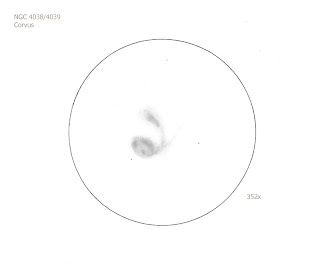The night of Saturday 7th August into Sunday was clear, although not as good as the previous Wednesday, so I pulled the scope out for a session looking for some summer Herschel 400 objects.
Conditions:
Clear, fairly warm, around 15C
NELM 6.0
Fairly humid with quite a lot of dew
Seeing II
Transparency II
Equipment: 12″ f5 Dob, 35mm Televue Panoptic (43x), 22mm Televue Panoptic (69x), 15mm Televue Plossl (101x), 11mm Televue Plossl (138x), OIII, UHC
NGC 6834, open cluster in Cygnus – irregular, attractive cluster made up of a line of 5 brighter stars crossing an elongated haze. At 138x, most of the haze resolves into faint stars.
There’s a separate clump to the immediate south of the main cluster, a knot of 10, or so, stars and another to the north, which has six stars.
NGC 6866, open cluster in Cygnus – Large, irregular cluster. Two chains of stars extend out from centre, one to the west and the other to the right. the western one is short and contains 7 brighter stars plus fainter ones. The eastern chain is longer and contains > 15 stars in a looping pattern.
There is a wide pair to the south.
Went after NGC 7044, but this was in the ‘dob hole’ and awkward to get at. One for another night, further into autumn when Cygnus is more to the west and that part’s easier to get at.
NGC 7027, planetary nebula in Cygnus – not on the H400 list but I was in the area. I am not sure why I found this easily and not 7044, but then a PNe’s easier to recognise than one of the myriad of open clusters and knots in the Milky Way in the Cygnus area.
7027 could easily be overlooked as just another star, as it is star like. However it isn’t stellar as at 69x it looks slightly fuzzy and an OIII filter makes it really jump out as a PNe.
At 138x its oval with no obvious darkening in the centre.
NGC 7296, open cluster in Lacerta – quite small, but conspicuous cluster near Beta Lacertae. Some stars resolved at 69, more resolved at 101x.
NGC 7243, open cluster in Lacerta – large, irregular cluster which fills the field of view of the 22mm Panoptic (69x). There are at least 23 brighter stars and many more fainter ones. Nice.
NGC 7209, open cluster in Lacerta – large and quite bright. Around 40 to 50 stars resolved. A very vague, rounded ‘m’ shape.
I finished up with a trip into the North America and Pelican nebulae, using my 35mm Panoptic and 2″ UHC filter. This was lovely, with wisps and and tendrils of subtle nebulosity everywhere. Here and there, hard edges were defined. Very nice indeed.
The next morning I found that, as the air heated up in the morning sunshine (Sunday was a hot day) my mirror had condensation on it. This is not good as repeated dewings up will cause the coating to deteriorate and fail and I don’t want to have to pay out for a recoating before I get my 20″. I opened up the scope and left it to dry out in the shed, with the shed doors open.
I posted on Cloudy Nights, asking how I can prevent this and most responses involved rigging up some kind of heating system. I am going to have to pay out for a car battery, an inverter and a lamp in the first instance and then, when I can afford it, a solar panel, at least 70w. However, a cheaper solution might be a large power pack with built-in inverter. That should run a low-watt lamp for a few hours to keep the mirror dry while the outside temps rise, although I am not sure exactly how long the charge would last, although some of these machines are pretty heavy-duty things. In the meantime, I have packed a couple of socks with silica gel and hung them inside the tube near, but not on, the mirror, then sealed the scope at both ends. I also went to Sainsbury’s and bought a bag of silica gel (not clay) cat litter which I’ll decant into socks and then hang inside the scope, tomorrow. Considering that quite a few of my socks have conspired to vanish, leaving only odd ones, they can do something useful! I blame the black hole that must be lurking somewere in the washing machine. The silica gel cat litter idea was also suggested on CN, stuffed socks and beanbags are the preferred method of holding them although, apparently someone once used a stuffed animal. WTF??!!






















